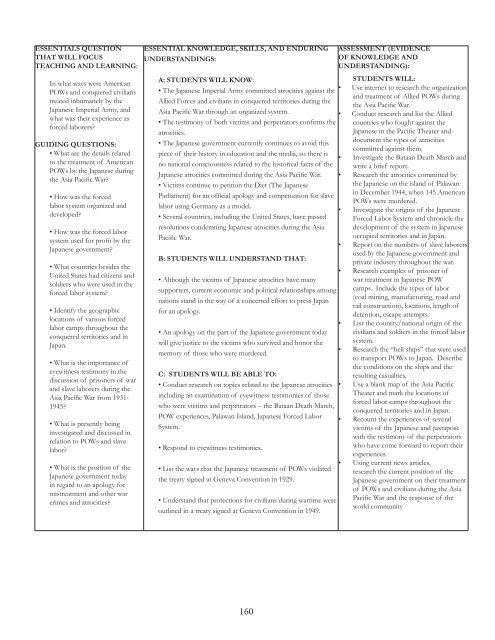Download - Canada ALPHA
Download - Canada ALPHA
Download - Canada ALPHA
Create successful ePaper yourself
Turn your PDF publications into a flip-book with our unique Google optimized e-Paper software.
ESSENTIALS QUESTION<br />
THAT WILL FOCUS<br />
TEACHING AND LEARNING:<br />
In what ways were American<br />
POWs and conquered civilians<br />
treated inhumanely by the<br />
Japanese Imperial Army, and<br />
what was their experience as<br />
forced laborers?<br />
GUIDING QUESTIONS:<br />
• What are the details related<br />
to the treatment of American<br />
POWs by the Japanese during<br />
the Asia Pacifi c War?<br />
• How was the forced<br />
labor system organized and<br />
developed?<br />
• How was the forced labor<br />
system used for profi t by the<br />
Japanese government?<br />
• What countries besides the<br />
United States had citizens and<br />
soldiers who were used in the<br />
forced labor system?<br />
• Identify the geographic<br />
locations of various forced<br />
labor camps throughout the<br />
conquered territories and in<br />
Japan.<br />
• What is the importance of<br />
eyewitness testimony in the<br />
discussion of prisoners of war<br />
and slave laborers during the<br />
Asia Pacifi c War from 1931-<br />
1945?<br />
• What is presently being<br />
investigated and discussed in<br />
relation to POWs and slave<br />
labor?<br />
• What is the position of the<br />
Japanese government today<br />
in regard to an apology for<br />
mistreatment and other war<br />
crimes and atrocities?<br />
ESSENTIAL KNOWLEDGE, SKILLS, AND ENDURING<br />
UNDERSTANDINGS:<br />
A: STUDENTS WILL KNOW:<br />
• The Japanese Imperial Army committed atrocities against the<br />
Allied Forces and civilians in conquered territories during the<br />
Asia Pacifi c War through an organized system.<br />
• The testimony of both victims and perpetrators confi rms the<br />
atrocities.<br />
• The Japanese government currently continues to avoid this<br />
piece of their history in education and the media, so there is<br />
no national consciousness related to the historical facts of the<br />
Japanese atrocities committed during the Asia Pacifi c War.<br />
• Victims continue to petition the Diet (The Japanese<br />
Parliament) for an offi cial apology and compensation for slave<br />
labor using Germany as a model.<br />
• Several countries, including the United States, have passed<br />
resolutions condemning Japanese atrocities during the Asia<br />
Pacifi c War.<br />
B: STUDENTS WILL UNDERSTAND THAT:<br />
• Although the victims of Japanese atrocities have many<br />
supporters, current economic and political relationships among<br />
nations stand in the way of a concerted effort to press Japan<br />
for an apology.<br />
• An apology on the part of the Japanese government today<br />
will give justice to the victims who survived and honor the<br />
memory of those who were murdered.<br />
C: STUDENTS WILL BE ABLE TO:<br />
• Conduct research on topics related to the Japanese atrocities<br />
including an examination of eyewitness testimonies of those<br />
who were victims and perpetrators – the Bataan Death March,<br />
POW experiences, Palawan Island, Japanese Forced Labor<br />
System.<br />
• Respond to eyewitness testimonies.<br />
• List the ways that the Japanese treatment of POWs violated<br />
the treaty signed at Geneva Convention in 1929.<br />
• Understand that protections for civilians during wartime were<br />
outlined in a treaty signed at Geneva Convention in 1949.<br />
160<br />
ASSESSMENT (EVIDENCE<br />
OF KNOWLEDGE AND<br />
UNDERSTANDING):<br />
STUDENTS WILL:<br />
• Use internet to research the organization<br />
and treatment of Allied POWs during<br />
the Asia Pacifi c War.<br />
• Conduct research and list the Allied<br />
countries who fought against the<br />
Japanese in the Pacifi c Theater and<br />
document the types of atrocities<br />
committed against them.<br />
• Investigate the Bataan Death March and<br />
write a brief report.<br />
• Research the atrocities committed by<br />
the Japanese on the island of Palawan<br />
in December 1944, when 145 American<br />
POWs were murdered.<br />
• Investigate the origins of the Japanese<br />
Forced Labor System and chronicle the<br />
development of the system in Japanese<br />
occupied territories and in Japan.<br />
• Report on the numbers of slave laborers<br />
used by the Japanese government and<br />
private industry throughout the war.<br />
• Research examples of prisoner of<br />
war treatment in Japanese POW<br />
camps. Include the types of labor<br />
(coal mining, manufacturing, road and<br />
rail construction), locations, length of<br />
detention, escape attempts.<br />
• List the country/national origin of the<br />
civilians and soldiers in the forced labor<br />
system.<br />
• Research the “hell ships” that were used<br />
to transport POWs to Japan. Describe<br />
the conditions on the ships and the<br />
resulting casualties.<br />
• Use a blank map of the Asia Pacifi c<br />
Theater and mark the locations of<br />
forced labor camps throughout the<br />
conquered territories and in Japan.<br />
• Recount the experiences of several<br />
victims of the Japanese and juxtapose<br />
with the testimony of the perpetrators<br />
who have come forward to report their<br />
experiences.<br />
• Using current news articles,<br />
research the current position of the<br />
Japanese government on their treatment<br />
of POWs and civilians during the Asia<br />
Pacifi c War and the response of the<br />
world community


